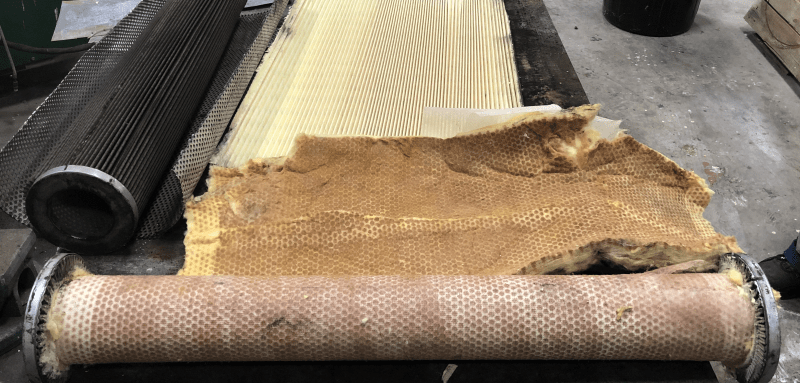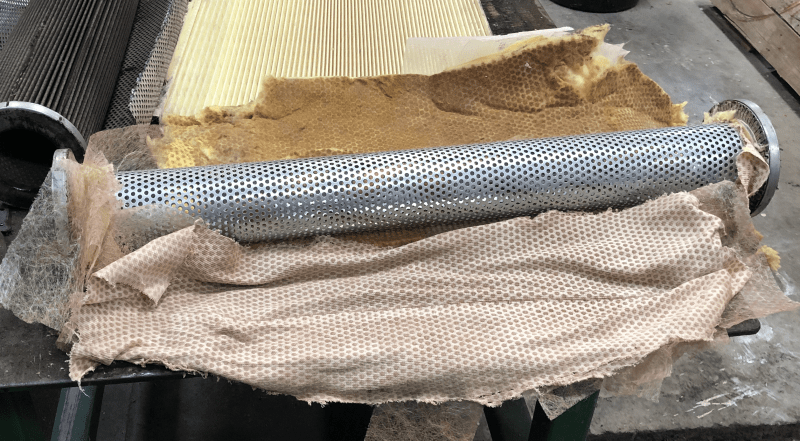We had a natural gas filter differential pressure reading that we can not explain. Maybe someone could help.
The equipment is a filter OD 1320mm horizontal pressure vessel, design pressure 80 bar. It contains 37 cartridges D192mm X d90mm X 878mm. Design flow 500.000 Nm3/h at line pressure 40 bar. Flow direction in the cartridge is from outside to inside.
Normal reading of differential pressure was about 100 mbar at 400.000 Nm3/h.
After an upset that lasted about 10-20 sec (the upset was 1 or 2 cycles of increase of flow to about 600.000 Nm3/h, followed by a sudden decrease to about zero flow, and finally a stabilization to the original flow of 400.000) the dp reading dropped to about 25 mbar. During the upset, maximum dp exceeded 400 mbar but remained below 500 mbar.
We suspected that some cartridges were damaged and we opened the filter. Unexpectedly, none of the cartridges was damaged, and everything seemed ok. We replaced the cartridges. After putting the new filter in operation, the dp reading was 40 mbar with 400.000 Nm3/h. The "old" type of cartridge is identical to the "new". We also checked the accuracy of the pressure transmitter and found it very reliable.
We checked 6 of the 37 old cartridges in detail. All were found to be similar. They had an "expected" dust on the surface of the pleated paper. The filtering media layers under the paper were intact, without any sign of letting the gas pass unfiltered. No deformation or sign of gas passing through the end caps.
At first, we thought that the upset could remove some of the "blocking" dust of the filter, leaving it with much lower dp than initially, but the new filters give a higher dp than the old ones. We really can not explain that.
Any ideas?
The equipment is a filter OD 1320mm horizontal pressure vessel, design pressure 80 bar. It contains 37 cartridges D192mm X d90mm X 878mm. Design flow 500.000 Nm3/h at line pressure 40 bar. Flow direction in the cartridge is from outside to inside.
Normal reading of differential pressure was about 100 mbar at 400.000 Nm3/h.
After an upset that lasted about 10-20 sec (the upset was 1 or 2 cycles of increase of flow to about 600.000 Nm3/h, followed by a sudden decrease to about zero flow, and finally a stabilization to the original flow of 400.000) the dp reading dropped to about 25 mbar. During the upset, maximum dp exceeded 400 mbar but remained below 500 mbar.
We suspected that some cartridges were damaged and we opened the filter. Unexpectedly, none of the cartridges was damaged, and everything seemed ok. We replaced the cartridges. After putting the new filter in operation, the dp reading was 40 mbar with 400.000 Nm3/h. The "old" type of cartridge is identical to the "new". We also checked the accuracy of the pressure transmitter and found it very reliable.
We checked 6 of the 37 old cartridges in detail. All were found to be similar. They had an "expected" dust on the surface of the pleated paper. The filtering media layers under the paper were intact, without any sign of letting the gas pass unfiltered. No deformation or sign of gas passing through the end caps.
At first, we thought that the upset could remove some of the "blocking" dust of the filter, leaving it with much lower dp than initially, but the new filters give a higher dp than the old ones. We really can not explain that.
Any ideas?


